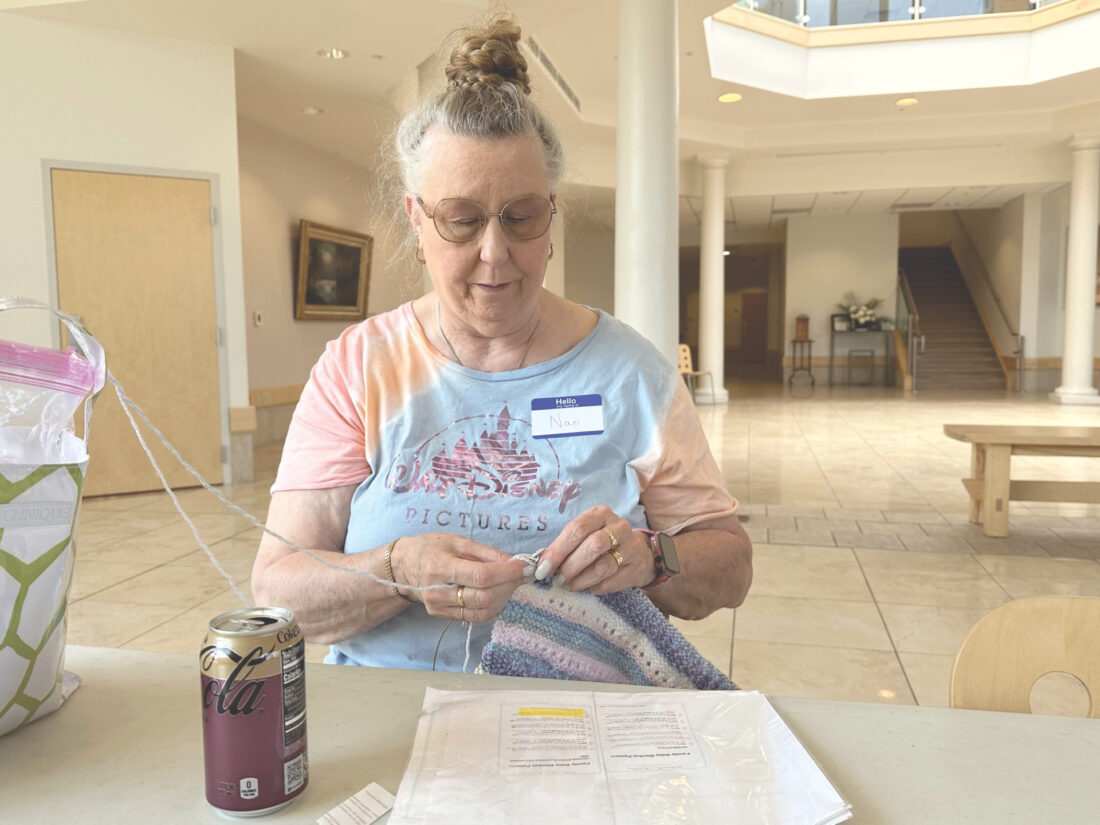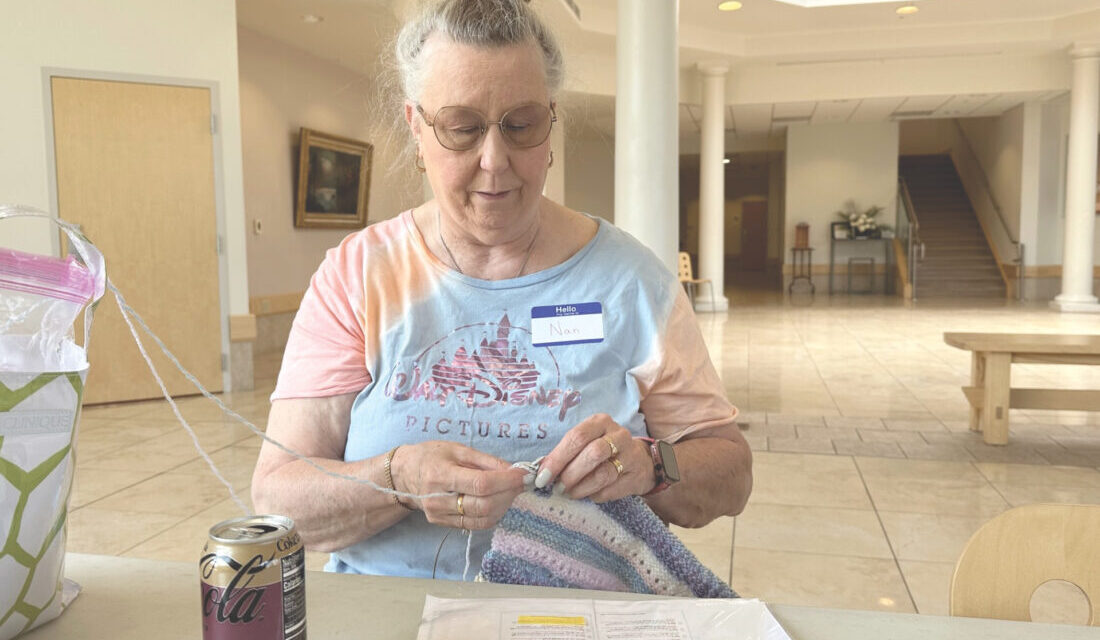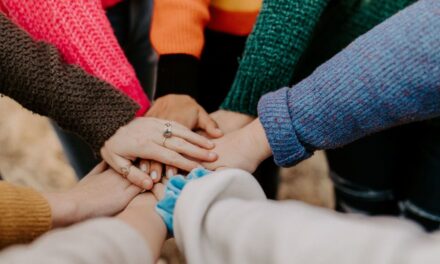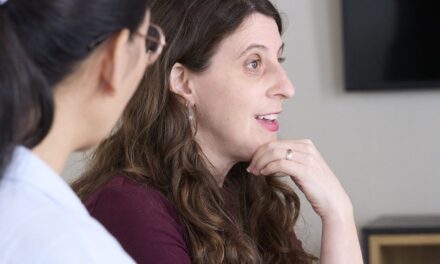
Nan Spawr-Seaton of Marquette knits a baby afghan during a recent meeting of the Lake Superior Knitters at the Marquette Regional History Center. The drop-in group meets the second and fourth Tuesdays of the month at the MRHC. (Journal photo by Christie Mastric)
MARQUETTE — It’s not about who can make the biggest crib blanket or the most colorful hat.
The group known as the Lake Superior Knitters at the Marquette Regional History Center meet to knit, of course, but it’s also about sharing stories of their daily lives and making observations of the world.
Mary Ann Theis, or the “boss” as her fellow members jokingly call her, talked about the group, which meets from 1 to 2:30 p.m. — or however long some people want to stay — on the second and fourth Tuesdays of the month at the MRHC.
The drop-in group asks for financial donations of $1 to $5 only to support the MRHC, she said.
Theis began the Lake Superior Knitters because she noticed many older individuals weren’t going as much to UP North Knitting Guild nighttime gatherings.
“They don’t want to drive for the winter to go to night events,” she said.
Also, others told her they like to knit but they have children, which makes going to nightly meetings more inconvenient. Thus, the Lake Superior Knitters meeting during the day helps solve that issue, although Theis acknowledged that mostly seniors come to the meetings.
Theis based the group on what she learned at Northwestern University, where she worked in the accounting department.
“You find a subject you all have in common and have an interest and want to learn more, and you have some background in how to do something,” Theis said.
She said she didn’t start to knit until she was 66 years old, but her fellow knitters have much more knowledge.
They also can be of varying ages and skill levels.
“There’s always a different mix of women,” Theis said.
Each meeting is different. For example, one woman brought yarn samples to the most recent meeting on Tuesday after spring cleaning, Theis said.
“She’s got a whole room full of yarn,” she said.
Theis said local quilter and fiber artist Judy Parlato recently talked to the group about the use of color.
“People sometimes do nice knitting, but sometimes their color combinations are ‘different,’” she said.
So, Theis is trying to have a speaker or special activity every two months.
“These women are very friendly to each other,” she said. “They’re very good at sharing their information.”
With today’s active lifestyles and social media, it could be a challenge to keep the knitting pastime alive.
The Lake Superior Knitters could keep that going.
“I think it’s good for people up here because it’s a socialization and it’s an art,” Theis said. “So many places put, ‘It’s a craft’ and ‘It’s a hobby.’”
Knitting dish cloths could be considered a craft, she said, but there’s also a lot of beautiful work that knitters create.
“They don’t want to enter contests and stuff because they don’t think it’s good enough,” Theis said, noting that people have different tastes in the art world. “Some people like impressionists and different types, but if you use a nice wool and you use nice patterns, it’s very time-consuming to make a lot of these pieces.”
For instance, Theis said it would take about 40 hours to make a hat using Shetland wool because the hair is so fine that it’s almost like embroidery thread.
Still, she believes knitting is worth the time.
“I think it’s good because it gives people something to do each day,” she said, plus knitters can create items for the community. “It gives them a purpose.”
Even youngsters can benefit from the activity, she said.
“I think for children, it’s good because it’s very calming, and it teaches math skills,” Theis said. “We have geometry. You have to figure out how many stitches.”
In fact, she noted that knitting skills, with their rhythm and consistency, could be passed on to children with disabilities to help them.
Knitting also can cross gender lines.
Theis said she has heard that the Bothwell Middle School knitting program has boys interested in the activity.
“People think only women do this, but if you’ve gone to the United Kingdom, you see all this beautiful work that’s done by men and women,” Theis said.
She also pointed out that she had read that knitting helped people with post-traumatic stress disorder.
“They didn’t use that term in World War I,” Theis said.
However, the clicking of the needles and the constant motion reportedly was soothing to people under bomb threats, she said.
Nan Spawr-Seaton of Marquette worked on a baby afghan at the Tuesday meeting. That afghan, she stressed, is being made out of acrylic yarn since it can be washed more easily than wool — a trait that comes in handy with babies who could spit up and make a mess.
“I absolutely love knitting,” Spawr-Seaton said. “I recently retired, and now I can get away and actually do my knitting, and I love socializing with other knitters.”
Kathy Peters of Marquette Township specializes in hats, including bright orange-and-white hats she gave to her kids to keep in their cars — for safety’s sake.
“If you’re having trouble, you put this on, you’re going to show up,” Peters said.
She too doesn’t make wool items for kids.
“They have to get washed, and Mommy has to fuss around, not shrinking them,” Peters said.
Using acrylic yarn sparked a conversation on when the synthetic material was invented — and it’s those kinds of talks that make the Lake Superior Knitters gatherings unique.
“It’s been a fun project,” Peters said of her hat-making endeavor. “It’s keeping me busy.”




